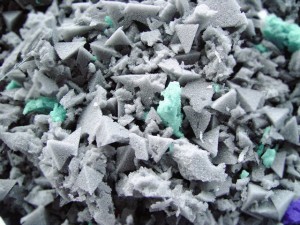When it comes to selecting a seat cushioning material for chairs or couches, people often say that they want the firmest, longest-lasting foam they can get. These people usually have traditional, open-cell, high-density foam in mind when they say these things. However, most don’t realize that if all open-cell foams were available options, rebond foam represents a choice that far surpasses traditional cushioning materials in density, firmness, and durability.

Because of its high values in traditional comfort categories however, rebond is generally too rigid and firm for comfortable use in thicker applications like couch cushions. For an example of its strength and firmness in even small dimensions, rebond foam padding is often used in thicknesses less than an inch for carpet padding, which bears the full, targeted weight of a standing, walking body.
This is because rebond isn’t a traditionally-formed foam material. Rather than a poured and expanded polyurethane product, rebond is made by shredding multiple varieties of pre-formed foam into small pieces and bonding them all under compression with adhesive. The bonding agents used gives the foam additional strength and rigidity that a traditional material can’t match. The adhesive also contributes to the the material being too firm for use as a mattress or soft cushion.
This isn’t to say that rebond foam doesn’t have a place in the world of comfort. To the contrary; rebond satisfies a handful of very demanding niches that traditional forms aren’t able to. For industrial seating applications, as well as seating on recreational vehicles, rebond provides durability with enough comfort to meet each use’s demands.
Industrial, public, and commercial seating have a substantially different set of expectations than the recliner in your living room. Church pews or restaurant booths for example, receive abuse that residential seating would never be expected to endure. Day in and day out, multiple people get in and out of these seats, often plopping themselves down less-than-gracefully and scooting in and out. This kind of pressure and wear would tear lesser foams quickly, but with rebond’s strength, these seat cushions are able to handle the abuse while still offering cushioning that’s softer than a wooden bench or pew alone. Imagine the pressure kneeling pew cushions receive from church-goers, or the forces of people sliding on and off of restaurant and bar stools all day. Not only are these pieces of furniture expected to be comfortable, they are supposed to stay comfortable for years, since removing seating for reupholstering in heavily-frequented areas isn’t something people want to be doing often. Rebond foam is able to provide that long-term padding, while offering enough comfort for the duration of a meal or sermon.
Another demanding application where rebond excels is in seating for recreational vehicles. ATV seats, motorcycle seats, and even a snowmobile seat will not only receive punishment from a rider bouncing and moving around, but also the constant vibrations of an engine. These motor vibrations can quickly break down a material not made to hold up, but rebond, again, is able to do so. Rebond is firm enough to give riders the support they need to stay in control of their vehicles, while also being able to be tailored to a rider’s preferences. Custom motorcycle seats are a particularly popular use for rebonded foam, since they can be trimmed from larger blocks or glued sheets. Whether they’ve worn out after years of use or don’t fit as well as they should, a DIY motorcycle seat made of rebond foam has improved the open-road experience of many riders over the years.
The versatility of foam materials in general is hard to match, and there are very few applications where a specialty material can’t fulfill a set of needs where a more common product may not suffice. Rebond’s performance in applications that require durable seating is a perfect example of this.
Foam Factory, Inc. stocks 7LB, 70ILD rebond foam in 1 and 2 inch thickness and two different sheet sizes. For more information on rebond foam, visit its product page.


Would you recommend this foam to be used for dining room chairs?
Rebond foam can be used for that application. However, we would suggest either our firm Lux-Regular foam or our firm Lux-HQ foam for that application.
question.. I’m looking to make a mixed density foam motorcycle seat, where the density is higher under my hips and less dense (softer) in the middle front of the seat. the idea being to lessen the pressure on sensitive areas and let my hips carry all the weight. I was think of shaping the dense foam with the debonded foam and the other softer foam with the lux-regular (or something of that sort). My questions are these: how can you bond/glue the two shapes of foam together so the seat surface is fairly intact, and is that even advisable? or should I merely try to solve the pressure issue with shaping the foam?
Yes, that is possible. Our 3M Super 77 spray adhesive can be used to piece the foam together.
Can an inch of rebond sheet be used as a top layer for a medium-firm mattress so it feels firmer to sleep on?
Typically toppers are used to make your mattress softer. If you are looking for firmness, that usually means the mattress needs to be replaced.
It looks like raw rebond foam stock isn’t available. Only chair pad is available. Typing “70ILD ” in the search bar returns nothing. Where can I get “rebond foam” for my project? Tks.
We actually just started carrying Rebond Foam, so you can feel free to purchase from the sheet sizes offered on our website.